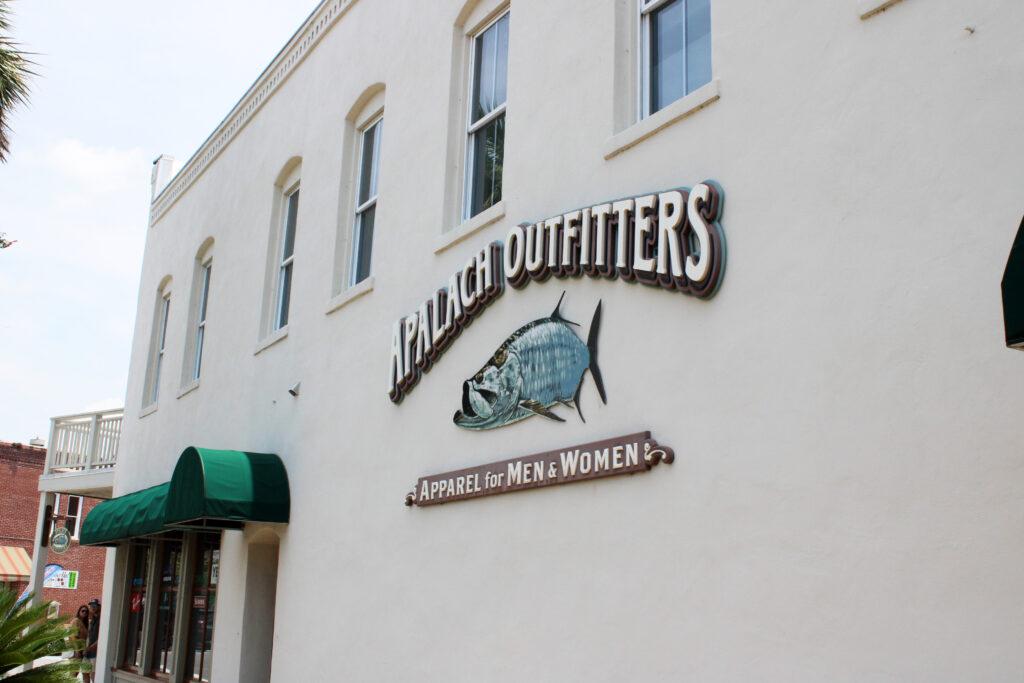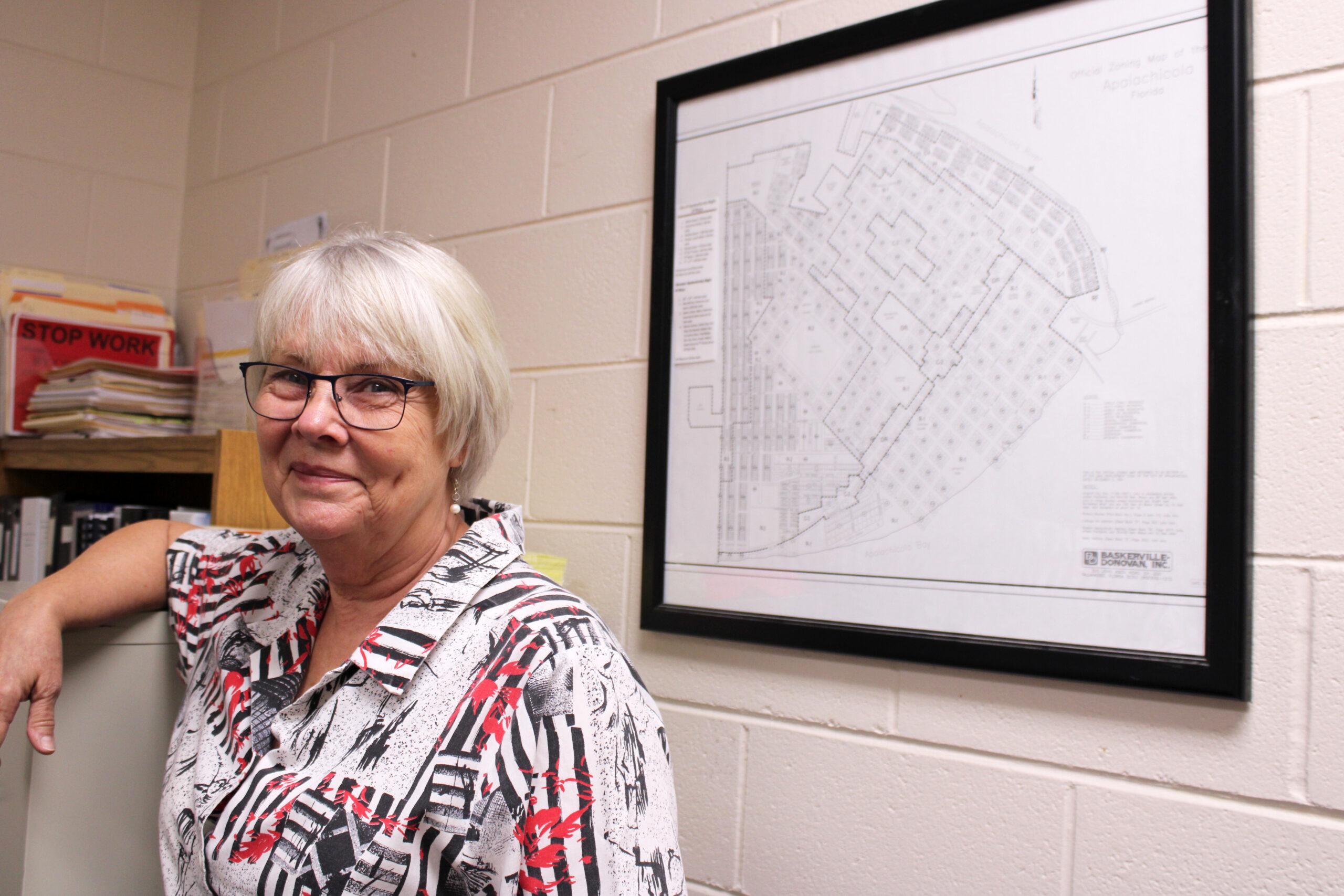City to revise sign ordinance
For the first time in 15 years, the Apalachicola city commission plans to revise its sign ordinance, following an extended review of the issue by members of the planning and zoning board.
At a joint workshop June 22 between city commissioners and P & Z, the city set in motion a process that could lead to a vote on revisions as early as the Aug. 8 regular commission meeting, following a second sign workshop July 19 at 5 p.m.
The commissioners unanimously supported Mayor Brenda Ash’s call for moving quickly on loosening the sign restrictions from the current maximum of 24 square feet. In addition, P & Z members have determined updates must be made to the lighting portions of the ordinance, which was last reviewed on a systematic basis in 2008.
P & Z had been looking into aspects of the sign ordinance for over a year, with a series of workshops, but the matter bubbled over the edge of the slowly simmering legislative pot at the June 6 city commission meeting.
It was then that Isabel Pateritsas, owner of the newly opened Izzy’s Place at the four-way traffic light on Avenue D and 12th Street, spoke before commissioners, regarding her sign being out of compliance because it was eight square feet over the size maximum.
“I think it’s obvious the sign ordinance is either outdated or unrealistic,” said Pateritsas. “I’m asking for it to be modified, and I’m asking what I should do in the meantime.
“I’m being told to go through P & Z and arrange for a smaller sign,” she said. “I don’t think it’s fair that I take steps and spend money to replace a sign when I am not the only one who is noncompliant. All I’m asking is (for the ordinance) to be applied fairly.”
The new code enforcement officer, P.J. Erwin made clear her enforcement of the ordinance was not prompted by a belief the sign was garish or inappropriate.
“I told Isabel I was ecstatic” at the look of her new restaurant,” she told commissioners. “My very next thought was ‘Oh crap, it’s bigger than 24 square feet.” I knew I was obligated to act on it.
“We have to enforce the ordinance,” Erwin said. “We can’t unsee things.”
Apalachicola businessman Jerry Hall, who owns the Grill and the Old Time Soda Fountain among his enterprises downtown, told commissioners that 24 square feet “is kind of unrealistic” and asserted that 60 percent of signs in town are currently non conforming.
His call for a workshop was backed up by P & Z member Bobby Miller. “They (the business people) know what they need, they know what they want,” Miller said. “They’re the heart of the city and they’re getting beat up right now.”
At last week’s workshop, P & Z Chairman Al Ingles opened by voicing his agreement that the ordinance needs to loosen its sign size restriction. “Twenty-four square feet is not a viable solution,” he said.
He said that as a general rule, with a downtown building that has a wall 30 feet high, the current ordinance means signs can take up no more than about 2 percent of the square footage of the building’s face.
“Whether that’s adequate or not, I don’t know,” Ingles said. “The signs have to be proportional to the size of the building, and this could become disproportionate to smaller buildings.”
P & Z member Joe Taylor, who was keenly involved in the workshopping in 2008 of the sign ordinance, prior to his being appointed to P & Z, said a key issue at the time had been off-premise signs.
“People wanted the chance to have an ‘Open’ sign or a menu board outside, and the compromise was made,” he said, noting that a caveat was included that such signs could not block the sidewalk.
“There was a lot of input and what has happened is things have evolved,” Taylor said.
Erwin told the joint workshop the code has become difficult to enforce “because people don’t like it. It doesn’t seem to fit what people think (the rule should be).
“I just need clarity,” she said. “There are people that have changed locations and the issue of signs has moved to the front burner.”
Hall reiterated his view most downtown businesses find the current ordinance unworkable, and said businesses must make clear to passing motorists necessary information.
“We need to let people know where we are and we can’t do that with a little bitty sign,” he said. “People coming through can look and see that’s a restaurant (but with others) you can’t tell that unless there’s signage.
“There should be a fast track way to appeal the signage (decisions),” Hall said. “There ought to be a path you can take to ask for forgiveness or adjustment, whatever you want to call it.”
Apalachicola businessman Tom Morgan, who owns Apalach Outfitters, which sports a large, prominent sign at the corner of U.S. 98 and Avenue D, recommended the city hire an outside party to take a closer look at the ordinance. He pressed commissioners to detail their viewpoints on what effect ordinance revisions would have on existing signs.
“I stand up here not understanding what each of the five commissioners want out of the new sign ordinance,” he said. “I’m not sure what the goal is. The public deeds to hear if it’s important and what you want to do. What are you all going to do with existing businesses and their signage? That’s a hard issue. The real issue is how we’re going to juggle the existing signage.”

Commissioner Anita Grove addressed Morgan’s question directly. “This is just an evolution of the sign ordinance; it’s been talked about for many years,” she said. “They won’t be asked to tear down their sign to meet this new ordinance. Anything we do is grandfathered in.
“We’re all struggling with how to make this change,” Grove said.
City Planner Bree Robinson and Erwin shared with the workshop their outline of what a revised ordinance, one based on a percentage of wall space, might look like. Robinson said she and City Manager Travis Wade had reviewed ordinances from Vero Beach and Orlando.
Robinson said she looked at a building with a wall 35 feet high and 40 feet wide, and started with the most expansive of ordinances she looked at, that of Port St. Joe, which allows signage to fill up to 50 percent of the face of a building, which would allow an enormous 1,400 square feet of sign space.
As the percentages drop down from 50 percent, they would allow anywhere from 560 square feet of signage down to 140 square feet, which would be the maximum if 10 percent was the change.
“The percentage is 1.7 percent currently, and that percentage is pretty low. We could possibly set a percentage and a square footage cap,” Robinson said.
“These numbers are maximum amounts, it’s saying we will tolerate that amount as the maximum amount,” added Wade. “There are cities that have little bitty signs; we want to be a business-friendly city.”
Commissioner Adriane Elliott proposed in her motion setting 10 percent as the maximum percentage as the commission begins hammering out what will be the eventual number proposed.
She said she reviewed ordinances in Port St. Joe, St. Augustine and Pensacola, and noted the latter allowed for accessory signs not to exceed 100 square feet.
“Ten percent would be a good place to start,” Elliott said. “If we capped it at 10 percent, people could get something that is aesthetically pleasing.”
Commissioners indicated to varying extents that they wanted to take a laissez-faire approach to the new rules,
“I don’t want to micromanage any sign,” said Ash. “Normally your sign is a reflection of your business. The dimensions of signs, we have to tackle that. Each business is an original business; we are not cookie cutter. You can’t put it in one box; we have to give options for them.”
Commissioner Anita Grove reminded colleagues that it was nonetheless the responsibility of the commission to set workable restrictions.
“Essentially it’s up to us to say what we need to have,” she said, veering for a moment to the example of the sign at Sugar Kingdom, the new candy store on St. George Island.
“I’m surprised we can’t see it from here, it’s pink neon,” she said. “They (storekeepers in general) want it as big as they can get it and they want it as bright as they can get.”
Grove reassured Jimmy Gander, owner of a petroleum distributorship and service stations in Apalachicola, who had voiced concern that often his hands are tied when it comes to putting in signs provided to him by the corporations.
“They would work with our ordinances, we don’t have to do what they always want,” she said. “I know there are issues but I know Marathon (and other companies) are used to dealing with other cities.”
Commissioner Despina George supported the move to using percentages as the new standard, but like Grove, asked that city officials work up drawings of the various percentages so commissioners would have a clearer idea of the effect they would have on the look of the city.
“We might consider instead of having general regulations for all commercial zones, have separate ones for downtown, Highway 98 and the neighborhood commercial districts,” she said. “They may have different requirements, and there’s a big difference between signs that are flat and protruding signs.”
George also stressed that how a sign is measured is a key factor, with consideration as to what constitutes ground level, base or frame, and the like.
“We not only have to deal with size but the definition of measurement of the size,” she said.
Robinson and Erwin agreed to draw up 10 examples from each part of the city, although Ash was wary of handing them too much to do in a short time frame. “Giving too many directives is only going to delay the process,” she said.
Grove suggested city staff needs to provide a fewer, representative number of examples by July 14.
“I’ll pick ones that have been here a while, not in the last two years,” Robinson said.
In the end, members of both P & Z and the commission indicated they want to draw up a flexible revision.
“I think this place is Americana. What we have is different, not cookie cutter,” said P & Z’s Lee McLemore.
“I don’t know we need to copy any city, we’re our own town,” said Miller. “If you look around town, I don’t see anything offensive about any of our signs. The only thing offensive is they don’t meet code.”
Lighting changes to prompt revisions
Because of the changes in lighting technology, Apalachicola plans to modify its existing sign ordinance to better account for what’s on the market today.
“The technology has replaced incandescents,” said P & Z Chairman Al Ingles told city commissioners at last week’s joint workshop. “The code specifies wattage, which is irrelevant today.”
Ingles said a better measurement is luminosity, which is a measurement of how much light is put out by a fixture. “It’s an intensity level,” he said.
Ingles provided city commissioners with an overview of how setting a standard for allowable lumens would work. A single lumen is a measurement of light roughly equal to the output of a candle from a distance of one foot. So, for example, 100 lumens would be like having 100 candles all burning at once from a distance of one foot away.
It’s a complicated method of measurement and one which the commissioners will have to work out as they pursue changes to the sign ordinance by their Aug. 8 meeting.
It may involve having city staffers use a luminance meter to measure the output of signs.
“I don’t want it to be lit up like the Vegas strip, but I also don’t want to micromanage owners. I don’t want inappropriate or vulgar signs out there,” said Commissioner Donna Duncan. “We don’t want everything blinking or a huge sign that covers up a historical building. But nothing jumps out at me (now) that’s horrific.”
Commissioner Anita Grove said the city may want to add provisions that curtail using a sign whose brightness poses a hazard to motorists.




Meet the Editor
David Adlerstein, The Apalachicola Times’ digital editor, started with the news outlet in January 2002 as a reporter.
Prior to then, David Adlerstein began as a newspaperman with a small Boston weekly, after graduating magna cum laude from Brandeis University in Waltham, Massachusetts. He later edited the weekly Bellville Times, and as business reporter for the daily Marion Star, both not far from his hometown of Columbus, Ohio.
In 1995, he moved to South Florida, and worked as a business reporter and editor of Medical Business newspaper. In Jan. 2002, he began with the Apalachicola Times, first as reporter and later as editor, and in Oct. 2020, also began editing the Port St. Joe Star.